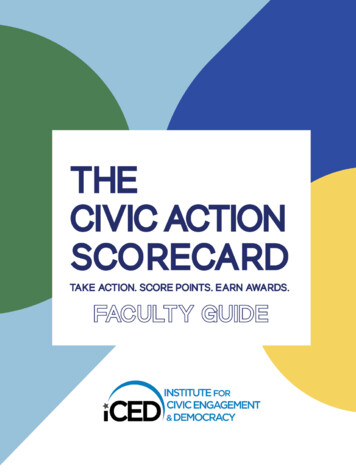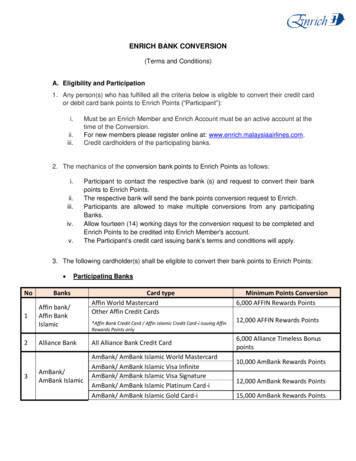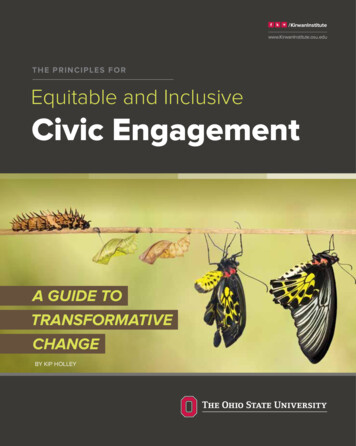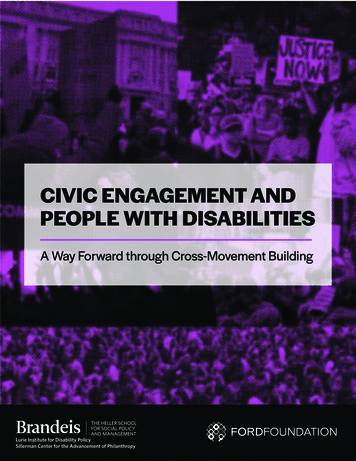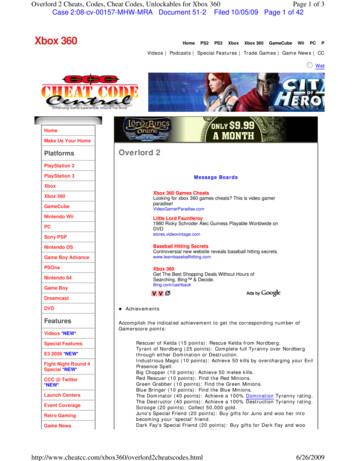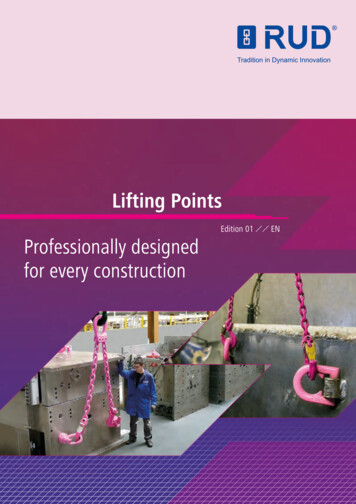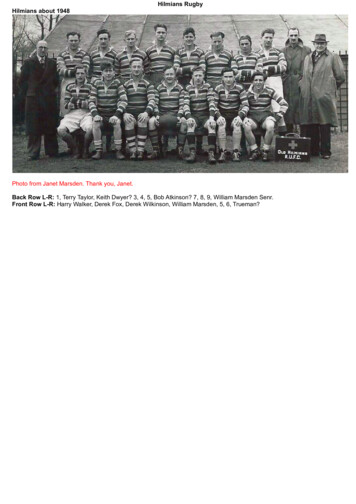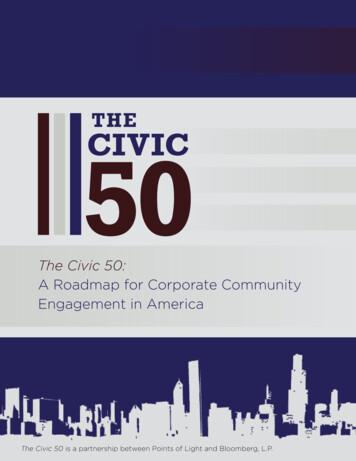
Transcription
The Civic 50:A Roadmap for Corporate CommunityEngagement in America1 Light and Bloomberg, L.P.The Civic 50 is a partnership between Points of
About Points of LightPoints of Light, the largest organization in the world dedicated to volunteer service,mobilizes millions of people to take action that is changing the world. Through affiliates in250 cities and partnerships with thousands of nonprofits and corporations, Points of Lightengages more than 4 million volunteers in 30 million hours of service each year. We putpeople at the center of change. For more information, go to www.pointsoflight.orgAbout Bloomberg, L.P.Bloomberg connects influential decision makers to a dynamic network of information,people and ideas. Our strength - quickly and accurately delivering data, news and analyticsthrough innovative technology - is at the core of everything we do. With over 15,500employees in 192 locations, we deliver business and financial information, news and insightaround the world.Yvonne Siu Turner, Senior Manager, Corporate Resources and Programs, Points of Light Corporate Institute, EditorThis publication is licensed under a Creative Commons Attribution-NonCommercial 3.0 Unported License. To useor distribute this resource, please attribute publication to Points of Light. For more information, please visit www.pointsoflight.org/corporate-institute or contact The Points of Light Corporate Institute at corporateinstitute@pointsoflight.org.Copyright 2014, Points of Light1
Table of ContentsOverview 3History 3Methodology 4Ranking 4Topline Highlights of 2014 5Four Dimensions: A Deeper Dive 10Investment 10Integration 12Institutionalization 13Impact 16Sector Highlights 17Communications 18Consumer Discretionary 20Consumer Staples 22Energy 24Financials 26Health Care 28Industrials 30Materials 32Technology 34Utilities 36Conclusion 38Acknowledgements 392
The Civic 50: A Roadmap for Corporate Community Engagement in AmericaOverviewIncreasingly, people support and punish corporations through their choice of work,purchases and investments. Yet there is little information on corporate communityengagement to help employees, consumers and neighbors decide which companies tosupport. The Civic 50, an initiative of Points of Light, in partnership with Bloomberg LP,honors the 50 most community-minded companies in the nation each year as determinedby an annual survey. By sharing the best practices of community engagement andbenchmarking companies against each other, The Civic 50 presents a roadmap for howcompanies are using their time, skills and other resources to improve the quality of life intheir communities.This report presents the highlights from the 2014 Civic 50. Its objectives are, first, torecognize the most community-minded companies in the nation and, second, to highlighta path forward for business managers and corporate social responsibility leaders who wantto embrace the principles of The Civic 50 so that their companies can also be one of themost community-minded companies in the nation.The Civic 50 winners were selected based on four dimensions of their U.S. communityengagement program:Investment: How extensively and strategically the company applies itsresources to community engagement, including employee time and skills,cash, in-kind giving and leadership.Integration: How a company’s community engagement programsupports business interests and integrates into business functions, or howit “does well by doing good.”Institutionalization: How the company supports communityengagement through its institutional policies, systems, and incentives.Impact: How a company measures the social and business impact of itscommunity engagement program.HistoryThe Civic 50 was founded in partnership with the National Conference on Citizenship(NCoC) and Points of Light in 2012, and developed with a high-profile working group oflead researchers and industry thought leaders. Additionally, dozens of corporate advisorsprovided strategic guidance on the program’s objectives, including defining indicators,developing methodology and identifying partners and participants. In the first two years,The Civic 50 evaluated and honored only S&P 500 companies. In response to feedbackfrom a panel of prominent academics and others, all U.S. companies with revenue of 1billion or more were invited to participate in 2014.3
MethodologyThe 2014 survey instrument consists of quantitative and multiple-choice questions thatinform The Civic 50 scoring process, and optional unscored narrative questions to capturepotential case study material for highlighting best practices. To calculate a corporation’sscore, points are accrued in the following dimensions: Investment (1,000 points),Integration (1,000 points), Institutionalization (1,000 points) and Impact (1,000 points).For the purposes of this report, all quantitative data refer to companies’ communityengagement in the United States.RankingThe Civic 50 are published as an alphabetical listing, however this year’s survey also rankedthe top three companies across ten sectors: communications, consumer discretionary,consumer staples, energy, financials, health care, industrials, materials, technology andutilities. The number one ranked company in each sector is identified with an asteriskbelow. Only the rankings of the top 50 companies and the top three in each sector areshared publicly with attribution. Names and rankings of companies that participated in thesurvey, but do not have rankings qualifying in the top 50 or top three in each sector areconfidential.In 2014, the 50 most community-minded companies in the nation are:AbbVieDr Pepper Snapple GroupRaytheon CompanyAdobe Systems IncorporatedEli Lilly and CompanySAPAetnaFedEx CorporationSigma-Aldrich*Materials Sector LeaderAlcoaFreeport-McMoRan Copper & GoldSouthwest AirlinesAltria Group, Inc.Gap Inc.Sprint CorporationApollo Education GroupGEState Street CorporationAT&TGeneral MillsSymantec CorporationBank of AmericaHasbro, Inc.The Hershey CompanyBaxter International Inc.Health Care Service CorporationToyota Financial ServicesCaesars Entertainment*Consumer Discretionary Sector LeaderHewlett-Packard*Technology Sector LeaderTSYSCapital OneIntel CorporationUnitedHealth Group*Health Care Sector LeaderCenterPoint Energy*Utilities Sector LeaderIntuitUPS*Industrials Sector LeaderCitiKeyBank*Financials Sector LeaderValero Energy Corporation*Energy Sector LeaderComcast Corporation*Communications Sector LeaderMotorola Solutions, IncVerizonConAgra Foods*Consumer Staples Sector LeaderPacific Gas and Electric CompanyViacomCSAA Insurance Group - a AAA InsurerPrudential Financial, Inc.Western UnionDIRECTVPwC4
The Civic 50: Top-line Highlights of 2014Civic 50 data suggest we’re living in a world where companies increasingly play a positiverole in meeting community needs—through the power of their people and the power oftheir financial contributions. Four highlights from The Civic 50, presented below, suggestcompanies are expanding and deepening their involvement in their communities bystrategically integrating community engagement into their business strategies.1.Community engagement boosts employee engagementCivic 50 companies – including Caesars Entertainment, Comcast, Hasbro, Hewlett-Packard(HP), PwC, Toyota Financial Services and UnitedHealth Group – find that employees whoparticipate in community engagement initiatives score higher on morale, engagement,pride and/or productivity than employees who don’t. HP, for example, has data showingthat employees who participate in community engagement efforts have 13% higher moralethan those who don’t participate. Similarly, Hasbro’s employee survey revealed that thesecond-most referenced reason employees love working at Hasbro is the communityengagement program, second only to “year-round half day Fridays.”OFFRecognizing this link between community engagement and employeeengagement, 82% of Civic 50 companies offer employees paid time off tovolunteer and 84% of companies offer grant-matching opportunities.Half of all companies also include community engagement as a formalcomponent of employees’ performance reviews.The positive impact that community engagement has on employee engagement is wellsupported by research: Research by The Corporate Executive Board Company, involving millions of employeesacross several industries, found that, on average, every employee who participates incorporate community engagement activities adds 2,400 of value to the company as aresult of decreased turnover and increased employee engagement. 1An academic study published in the Journal of Marketing found that corporatecommunity engagement programs often boost employee engagement and customerservice levels. 2A Deloitte survey revealed that millennials are twice as likely to be very satisfied withtheir career progression when they have the opportunity to volunteer through theiremployer. 3The same Deloitte survey revealed that millennials are 24% more likely to recommendtheir company with strong corporate community engagement to a friend. 41Kropp, Brian. “Maximizing the Effectiveness of Corporate Volunteer Programs” (webinar). CEB. July, 2014.Korschun, Daniel, C.B. Bhattacharya, and Scott D. Swain. “Corporate Social Responsibility, CustomerOrientation, and the Job Performance of Frontline Employees,” Journal of Marketing, May, 2014.3Deloitte, Deloitte Volunteer IMPACT Survey, 2011.4Deloitte, Deloitte Volunteer IMPACT Survey, 2011.25
The following are specific ways that Civic 50 companies have formalized theircommunity engagement. Western Union’s employee performance objectives – which are the basis for professionalevaluations and bonuses – include a “Social Ventures” objective, which reinforces eachemployee’s commitment to using business assets to deliver business and social results.Such objectives can range from developing a new product that benefits a societal cause,to sourcing from socially responsible vendors, to incorporating community commitmentinformation into an external-facing sales deck. As part of its CodeGreen program – the company’s environmental sustainabilitystrategy – Caesars Entertainment collects data on a monthly basis from each businessunit on how employees are implementing and integrating CodeGreen initiatives intotheir work. With aggressive goals set for energy, water and waste, it is important thatevery employee makes an impact. With this data, managers are aware of the leadersand laggards and can drive action and empower employees by prioritizing actions. Theculture’s friendly competitive spirit encourages managers to challenge each other to dobetter – and create an environment where every employee is able to make a difference.This practice appears to work well for Caesars as HR data show that employees whoparticipate in CodeGreen have higher engagement scores than non-participants.Furthermore, research found that customers aware of CodeGreen are more loyal thanthose that are unaware of the program.2.Companies and communities find value in skills-based volunteering20%On average, one out of every five (20%) employee volunteer hours atCivic 50 companies are skills-based.Skills-based volunteering continues to grow at Civic 50 companies and on average, one outof every five employee volunteer hours at Civic 50 companies is skills-based. Skills-basedvolunteering provides communities with valuable, specialized support that can provide fivetimes greater value than traditional volunteering, according to True Impact and the Bureauof Labor Statistics.5 HP research also finds that employees who participate in skills-basedvolunteering are even more satisfied and experience an even greater bounce in morale fromvolunteering than those who only do extra-hands volunteering. Skills-based volunteeringcan also strengthen employee workplace skills, and 64% of Civic 50 companies use theircommunity engagement work it in this manner.Examples of skills-based volunteering at Civic 50 companies include: 5Motorola Solutions is an industry sponsor for a Chicago school identified by the Mayor’soffice as being high need. In addition to the company’s financial support, over 100Motorola Solutions employees serve as mentors to students. Mentors provide curriculumconcept assistance, career insight and general support to their mentees. Additionally,employees from the HR department provide guidance on the soft and hard skillsU.S. Bureau of Labor Statistics and 2012 Volunteerism ROI Tracker Analysis, True Impact, 2012.6
necessary for current and future positions at Motorola Solutions and the industry atlarge. PwC employees helped the Silicon Valley Education Foundation create a more efficientprocess to capture in-depth and relevant stakeholder information for their Step Upto Algebra (now called Elevate) program. And because communicating with parentsduring the program is critical to its success, PwC also advised on communicationenhancements to increase the likelihood that participating students succeed. Raytheon has touched the lives of more than four million students through partner andmentoring programs. Two-thirds of Raytheon’s employees are engineers who use theirskills to support communities through mentoring programs including Stand & Deliver,Math Nights and LASER – part of a nationwide effort to connect students with some ofthe world’s foremost engineers and business leaders. Raytheon also uses skills-basedvolunteering to support student veterans. Through its partnership with organizationslike Student Veterans of America, leaders from Raytheon volunteer to provide studentveterans with leadership mentoring and practical workplace insights. In total, Raytheonemployees have volunteered more than 575,000 hours over the past three years.3.Companies raise their voice to advance social changeNot long ago, societal issues like health and road safety were the responsibility ofnonprofits and governments. In the 21st century, however, business has expanded itssocietal role. Many business experts, including Harvard Business School corporate strategyguru Michael Porter, now advocate for community engagement as a strategic means ofgenerating financial returns.In fact, 82% of Civic 50 companies have taken a national leadership position on a socialissue like ending hunger, texting and driving and strengthening STEM education. Manycompanies invest in issues related to their own operations and are, therefore, often in aunique position to contribute lasting solutions.Civic 50 companies taking a lead on social issues include Aetna, AT&T and FedEx: Through the provision of healthcare solutions to the large and richly diverse U.S.population, Aetna has significant experience with the effects of inequality in healthcare. Aetna has taken a leadership role in addressing these inequalities. In 2002, forexample, Aetna developed policy on genetic testing and nondiscrimination that becamethe model for the industry. In 2008, it worked with legislators to help pass a moremeaningful mental-health parity law that allows for better coordination of coveragefor physical and mental health care services. Aetna was an active voice throughout thehealth care reform debate of 2009 and 2010. Indeed, the efforts of Mark T. Bertolini,Chairman, Chief Executive Officer and President of Aetna, have earned him recognitionas one of the 10 most influential leaders in the industry by ModernHealthcare.com. AT&T has taken a leadership position against texting and driving with its awarenessbuilding and behavioral-changing It Can Wait campaign. More than 2,500 organizationsand 65,000 individuals have joined the movement, more than 5 million pledges havebeen made never to text and drive, and the campaign has resulted in more than 1.8million downloads of the AT&T DriveMode app that silences incoming text messages7
when you’re driving and automatically sends a customizable auto-reply message tolet friends know you’re behind the wheel and will reply when it’s safe. It appears tobe working, as research on crash data from departments of transportation in Texas,Kentucky and other states suggests a correlation between It Can Wait campaignactivities and a reduction in crashes. 4.FedEx has also played a leadership role in advancing a social issue into which it haskeen insight – pedestrian safety. In honor of 15-year-old Christina Morris-Ward whowas killed on Halloween morning in 2012 after crossing an intersection while distractedwith headphones and her cell phone, FedEx launched its Moment of Silence Campaignin 2013. The public service campaign honors Christina and teens who are injured andkilled each year while crossing the street by bringing nationwide attention to the issueof pedestrian safety. It encourages teens and parents to pledge a “Moment of Silence”to put down their devices while crossing the street. This message has reached 241 cities,907 schools and 580,000 students around the world, and has engaged 12,000 parents,teachers and FedEx volunteers.Purpose is Aligned with ProfitData from Civic 50 honorees suggest that many businesses are moving away from checkwriting or banquets as means of contributing to the community. Instead, they designsophisticated community engagement programs that involve the business itself in doinggood while also supporting its own success. The specific business functions that companiesmost often integrate with their community engagement are marketing, skill development,and diversity and inclusion. More than 80% of Civic 50 companies integrate theircommunity engagement into each of these business functions.80%More than 80% of Civic 50 companies connect their communityengagement work to key business functions, including marketing/PR,sales, skill-development, recruiting or diversity and inclusion.Examples: General Mills’ Box Tops program empowers consumers to help their local schoolspurchase computers, books, playground equipment and other items of need. Parentsand students earn cash for their schools by clipping box tops from their Cheerios, BettyCrocker or other General Mills products. Two-hundred forty General Mills brands havehelped 90,000 schools earn more than 600 million since the program started in 1996. ConAgra Food’s Child Hunger Ends Here campaign increases consumer awarenessof child hunger and provides an easy way for them to help. Nineteen ConAgra Foodsbrands, including Blue Bonnet and Hunt’s, featured the Child Hunger Ends Here pushpinon packaging. Shoppers could enter the provided code at ChildHungerEndsHere.com totrigger one meal donation to Feeding America. The Toyota Financial Services (TFS) community relations team partnered with theirmarketing department to create their Go Green campaign. For every customer whocommitted to paperless billing, TFS donated 5 to Boys & Girls Clubs of America8
(BGCA). The campaign dramatically reduced TFS’s paper and printing costs, as well asits environmental impact. It also strengthened BGCA with a 200,000 donation anda public relations campaign that the organization would not likely have been able toafford otherwise. Motorola Solutions Foundation works with the Motorola Solutions Human Resources(HR) department to design community engagement programs that develop employees’hard and soft skills. For example, in 2013 the company completed 175 jointly plannedteambuilding volunteer events. They were so successful that CEO Greg Brown set a goalof 200 events for 2014. Furthermore, the company’s formal leadership developmentprogram for rising leaders includes skills-based volunteer opportunities. The Hershey Company considers an inclusive workplace and a diverse workforceas drivers for business results. As such, it uses community engagement as a way topromote these drivers. Business Resource Groups (BRGs) – including the AbilitiesFirst BRG, the African American BRG and the Veterans BRG – facilitate the company’spartnerships with diverse community groups. These partnerships strengthen the diversevoices within the company and provide key insights on a wide swath of consumers. As aresult, the company develops new products and marketing messages that are effectiveand resonate with diverse consumers, which helps business to grow.There is additional evidence supporting that purpose and profit are aligned: Harvard Business School research found that companies with more communityengagement practices significantly outperform their counterparts over the long-term,both in terms of stock market and accounting performance.6 Academic research has shown that, for firms in industries that are highly sensitive toconsumer perception, community engagement is associated with subsequent salesgrowth.7 Market research has found that 59% of Americans are more likely to buy a productassociated with a corporate-nonprofit partnership.8 Market research also reveals that 56% of Americans will travel an extra ten minutes outof their way to purchase a product that supports a cause they care about and that 71%are willing to pay more. 96Eccles, Robert G., Ioannis Ioannou and George Serafeim. “The Impact of a Corporate Culture of Sustainability onCorporate Behavior and Performance." Harvard Business School Working Paper, 2011.7Baruch, Lev, Christine Petrovitis and Suresh Radhakrishnan. "Is doing good good for you? How corporate charitablecontributions enhance revenue growth" in Strategic Management Journal, Sept., 2009.8Cone, Inc. "More than three-quarters of Americans say a nonprofit-corporate partnership makes a cause stand out" inTrend Tracker, March, 2010.9Do Well Do Good. The Do Well Do Good Second Annual Public Opinion Survey Report on Cause Marketing, 2012.9
The Civic 50’s Four Dimensions:A Deeper DiveIn The Civic 50, community engagement programs were evaluated againstfour dimensions: investment, integration, institutionalization and impact.Highlights from each of these dimensions are discussed actInvestmentThis dimension evaluates how extensively and strategically the company applies itsresources to community engagement in the U.S., including employee time and skills, cash,in-kind giving and leadership.By the Numbers: 10Employee Time and TalentThe Civic 50Average percentage of U.S. employees at Civic 50 companies thatparticipated in some type of company-sponsored volunteerism: 35%mobilized12,670,912volunteerhoursOn average, U.S. employees at Civic 50 companies volunteered a totalof: 5.73 hours annuallyThe average percentage of U.S. volunteer time at Civic 50 companiescategorized as skills-based volunteering per company: 20%On average, 35% of U.S. employees at Civic 50 companies participated in some type ofcompany-sponsored volunteerism. The average participation rate for other companies is30%. (2014 Giving in Numbers, Committee Encouraging Corporate Philanthropy)10For definitions, please see The Civic 50 Participant Packet online athttp://www.civic50.org/The Civic 50 2014 Participant Packet.pdf10
CashThe Civic 50contributeda total of 1,996,802,539in cash tocommunitiesAverage Civic 50 company cash contributions, including matchingfunds for company-sponsored giving of U.S. employees,(as a percentage of revenue) provided to U.S. social causes: 0.37%Average percentage of Civic 50 company cash contributions that arematches to U.S. employee giving: 13%Total value of Civic 50 company cash donations given for U.S.employee matches and Dollars-for-Doer grants annually was: 196,653,282Average number of individual U.S. grants per Civic 50 company,excluding matching-gift and volunteerism matching: 977On average, percentage of Civic 50 company U.S. grants providingadditional support such as company volunteers, in-kind goods orservices, and/or a multi-year pledge: 43%On average, Civic 50 companies contributed 0.37% of revenue to social causes.In-Kind ContributionsOn average,43%of Civic 50 granteesreceived additionalsupport in the form ofvolunteerism orin-kind donationsAverage cost of U.S. in-kind contributions (as a percentageof U.S. revenue) provided by Civic 50 companies to socialcauses annually: 0.17%Public LeadershipCivic 50 companies that took a leadership position on a specific social cause bypromoting public awareness or behavior change, or by advocating for policy change ateither the national or local level:64% said they took a leadership position on four or more national public education orpolicy advocacy efforts18% said they took a leadership position on one to three national efforts16% said they took a leadership position on four or more local efforts0% said they took a leadership position on one to three local effortsTo view the specific questions for the investment dimension, refer to pages 10 to 11 of The Civic 50 ParticipantPacket at: www.civic50.org/The Civic 50 2014 Participant Packet.pdf11
IntegrationThe Integration dimension measures how a company’s U.S. community engagementprogram supports business interests and integrates into business functions, or how it “doeswell by doing good.”80%More than 80% of Civic 50 companies connect their communityengagement work to key business functions, including marketing/PR,sales, skill-development, recruiting or diversity and inclusion.By the Numbers: Percentage of Civic 50 companies applying the practice in the U.S.Formal writtenstrategy – broadlyand consistentlyimplementedFormal writtenstrategy –implemented onlimited basisInformal strategybroadly andconsistentlyimplementedInformal strategyimplemented onlimited elopment46%18%14%4%Recruiting36%8%18%4%Stakeholder Relations54%10%8%0%Diversity andInclusion62%8%6%0%Health and 2%0%Business Functions(Top 5 per CompanyMax)To view the specific questions for this dimension, refer to pages 12 to 15 of The Civic 50 Participant Packet at:www.civic50.org/The Civic 50 2014 Participant Packet.pdf12
InstitutionalizationThis dimension evaluates how a company supports community engagement in the U.S.through its institutional policies, systems and incentives.By the Numbers:Community Input78% of Civic 50 companies have a formal structure to seek input from U.S.community leaders, such as a survey, focus group or community meeting14% have a formal, structured effort that passively collects feedback8% have informal, ad hoc conversationsPerformance ReviewsHalf (50%)of Civic 50companiesincludecommunity workin performancereviews forat least someemployees50% of Civic 50 companies include community engagement as aformal written component of employees’ performance reviews20% apply this policy to 75-100% of U.S. employees4% apply this policy to 50-74% of U.S. employees2% apply this policy to 25-49% of U.S. employees20% apply this policy to 1-24% of U.S. employees4% do not track or cannot disclose the percentage of employeesto which this practice applies13
Department Goals70%of Civic 50companiesincludecommunityengagementon departmentscorecards70% of Civic 50 companies have community engagement listedon division/department/business unit scorecards or evaluations30% apply this policy to 75-100% of U.S. employees8% apply this policy to 50-74% of U.S. employees10% apply this policy to 25-49% of U.S. employees18% apply this policy to 1-24% of U.S. employees4% do not track or cannot disclose the percentage of U.S.employees to which this practice appliesEmployee Incentives82%of Civic 50companiesallow employeespaid time off tovolunteer100% of Civic 50 companies offer awards and recognitionopportunities (both internal and external)84% offer U.S. grant-matching82% offer U.S. paid time off to volunteer76% of companies offer U.S. volunteer “Dollars for Doers” grantsResources100%of Civic 50companieshave onlineportals tosupport U.S.communityengagement98% offer toolkits to support community engagement efforts98% offer training94% send regular newsletters92% have affinity groups92% have social media platforms14
LeadershipLeadership participation in community engagement:72% of Civic 50 companies say that leadership participates in U.S. companycommunity engagement events or activities at least 12 times per year14% of companies say that leadership participates six to 11 times per year6% of companies say that leadership participates three to five times per year8% of companies say that leadership participates one to two times per year0% of companies say that they do not track or can’t disclose leadership participationLeadership encourages employee participation in community engagement:4% of Civic 50 companies say leadership encourages U.S. employee participation incommunity engagement events/acti
5 The Civic 50: Top-line Highlights of 2014 Civic 50 data suggest we're living in a world where companies increasingly play a positive role in meeting community needs—through the power of their people and the power of their financial contributions. Four highlights from The Civic 50, presented below, suggest companies are expanding and deepening their involvement in their communities by


